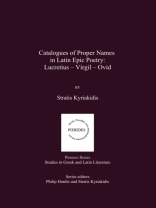The book consists of two main parts: a) Structure and Contents, b) Catalogues in Context: In the first part the major subject is how a catalogue is organized internally. A number of structural patterns formed since Homer on the basis of the position the names held within the catalogue (density in the middle – spacing in the middle -ascending /descending mode – internal balance – erratic pattern) were to continue down to the period of Lucretius, Virgil and Ovid. Each pattern carries its own dynamism in the text and has its particular effects in the reading process. Especially when the poetic work evolves in time, the fluctuation of the density in names per verse entails a corresponding fluctuation of the narrative tempo. On occasion the reader may also recognize in the structure of the catalogue a visual parallel to the situation described. Mirroring technique -widely applied in literary and artistic works in antiquity- finds its place in the poetic catalogues of the period and can be distinguished in three major categories: the extratextual, the intertextual, and the intratextual. In Ovid the technique became most sophisticated.The second part deals with the relation of the catalogue to its surrounding text. In this respect, catalogue-markers and the way a catalogue is introduced or completed are issues which are discussed in this part of the work, as they can be indicative of the way the poet views the contents of a catalogue. What becomes evident here is that the usual catalogue-markers are the products of the notion that whoever or whatever is included in a catalogue is listed there as an individual entity, even if some of its characteristics are neutralized. This proves to be true in Virgil where the items of a catalogue retain their value whereas frame and content function in support of each other. This also occurs in the greater part of the epic tradition. Before Virgil, however, in Lucretius, the frame was often the means of subverting the traditional function of a catalogue, since it usually called into question the very existence of the beings named, or undermined their value. On some occasions, a Virgilian catalogue does not close with a verbal frame but with a pause. This mode of closure proves to be the strongest boundary between a catalogue and the continuation of the narrative. On other occasions we shall find a simile at the end of a catalogue. These closural devices stress the catalogue’s potentials as they affect the reading process. Things change in the Ovidian Metamorphoses. Ovid makes extensive use of various poetic techniques and devices which he draws from the tradition in general and Virgil in particular. In doing so, however, he often challenges their significance and forms catalogues that give the impression of delaying, by protracting the oncoming narrative. In Ovid’s work neither the pause nor the simile can easily constitute natural barriers to his catalogues. Everything in the Metamorphoses is in a continuous state of flux and the catalogue, too, has to adapt accordingly by acquiring new characteristics with novel values.This book is the first of the series Pierides, series editors: Philip Hardie – Stratis Kyriakidis
Stratis Kyriakidis
Catalogues of Proper Names in Latin Epic Poetry [PDF ebook]
Lucretius – Virgil – Ovid
Catalogues of Proper Names in Latin Epic Poetry [PDF ebook]
Lucretius – Virgil – Ovid
Dieses Ebook kaufen – und ein weitere GRATIS erhalten!
Format PDF ● Seiten 250 ● ISBN 9781443809009 ● Verlag Cambridge Scholars Publishing ● Erscheinungsjahr 2009 ● herunterladbar 6 mal ● Währung EUR ● ID 2594522 ● Kopierschutz Adobe DRM
erfordert DRM-fähige Lesetechnologie












